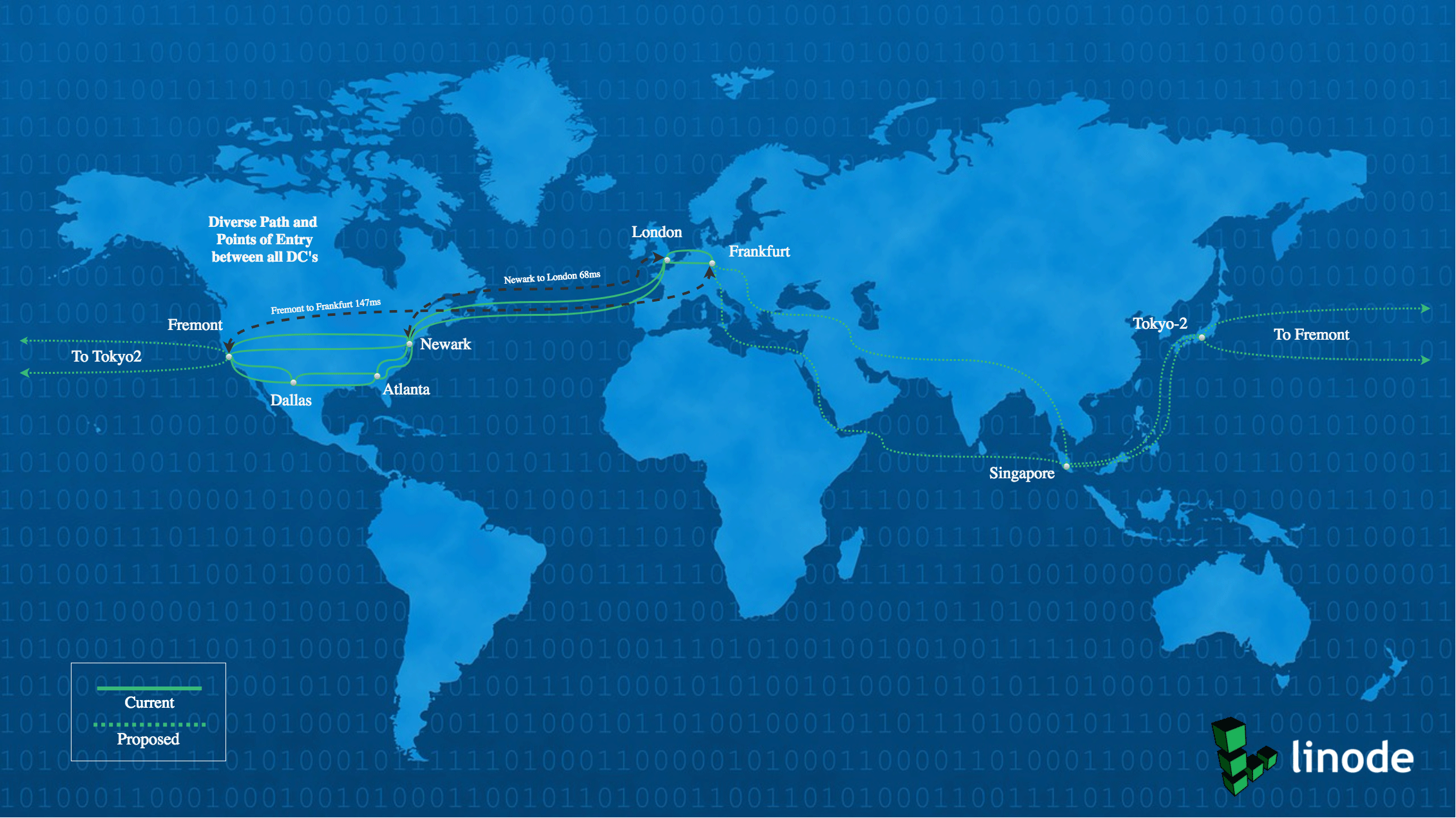Come abbiamo descritto nel nostro ultimo aggiornamento sulla rete, il nostro reparto di ingegneria di rete ha lavorato duramente per rinnovare la nostra intera rete rivolta a Internet, aumentando la capacità e facendo peering diretto con centinaia di reti in tutto il mondo. Da allora, abbiamo esteso la nostra dorsale di rete a tutti i datacenter del Nord America e dell'Europa. Ciò significa che le comunicazioni tra i datacenter Linode non lasceranno mai il nostro ASN 63949. La connettività privata diretta tra i nostri siti elimina la volatilità di Internet dall'equazione.
I clienti possono fidarsi del fatto che le loro applicazioni multi-sito ospitate presso di noi saranno in grado di comunicare attraverso i mezzi più veloci e affidabili possibili. I nostri ingegneri hanno lavorato a stretto contatto con i nostri fornitori per scegliere i percorsi in fibra più brevi possibili, che a loro volta offrono ai nostri clienti la latenza più bassa tra le sedi. Sul nostro attuale percorso più lungo (da Fremont DC a Francoforte DC), siamo stati in grado di ridurre l'RTT di oltre 15ms. Abbiamo anche visto scomparire gli inevitabili fenomeni di jitter e perdita di pacchetti legati a Internet.
Sebbene la connettività diretta tra le interfacce pubbliche di Linode sia ottima, non intendiamo fermarci qui. I nostri ingegneri hanno speso innumerevoli ore per costruire relazioni e forgiare accordi alla pari con centinaia di contenuti e reti di eyeball. Ora, con una dorsale di rete accelerata e rafforzata, possiamo estendere i benefici di queste relazioni, attualmente contenute in un singolo datacenter, a qualsiasi datacenter lungo la nostra dorsale. Ad esempio, i clienti di Newark potranno beneficiare direttamente delle nostre solide relazioni di peering in Europa e viceversa. Minore è il traffico inviato attraverso molteplici salti di transito, migliore è il cloud che offriamo ai nostri clienti.
Ora che i DC di Linode in Nord America e in Europa sono integrati, abbiamo iniziato a occuparci della nostra rete AsiaPAC. Durante un recente viaggio a Singapore, i nostri ingegneri di rete hanno acceso la fibra scura in uno degli edifici più densi di carrier in Asia, dandoci le basi per estendere la nostra dorsale anche lì.







Commenti (29)
To improve Asian network performance, Linode can consider lighting up dark fibres to Hong Kong solely as a network PoP. That way you can cover more Asian countries like the Philippines, Brunei, Taiwan, Cambodia and Vietnam and provide redundant routes for these countries as their links to Singapore or Tokyo are not as stable as the ones going to Hong Kong.
Good Job!!! Linode always Rocks…
Goooood job guys! So, there will be a global private network with a unique private IP range shared between Datacenters?
@Diego Thanks! It might be something we can consider, we’re always looking to make our service even better.
Excellent news 🙂 I’m in AsiaPAC exclusively at the moment, so I look forward to the work done there 🙂
Come to StrayaaAAA!
awesome Linode Rocks
Yeah yeah thanks Linode!!!
Any plans to increase egress, i.e. currently 1Gbs out?
Awesome job. Speed is important if one makes app syncing between two data centres
Great News!
We’ll love to have backup service across 2 datacenters ! (and private networks 🙂 )
E.
Next POP should be in Australia! Tons of business here!
+Stephen Reese
If you have a low cost Linode, than 1Gbps is a good amount of bandwidth for most usage scenarios. You could always set up a cluster of cheap Linodes over multiple datacenters in order to increase your aggregate bandwidth.
Does Linode with these network upgrades plan on increasing usage quotas on Linodes?
I’m getting 174ms latency between Fremont and Frankfurt. Your diagram says that should be 147ms.
What gives with that?
@John Our North American ring consists of diverse paths between each DC. The primary path between Fremont and Newark was down due to a fiber cut which caused traffic to take the longer secondary path. It just so happens that we were working with our provider to get the secondary path shorter which happened in the last 48 hours. RTT for both paths should be around 146ms now. Please let us know if you see otherwise!
Wow you guys are serious! Is transfer between DC’s “free” do you know? Just out of curiosity 🙂
Great news for those in Asia! Any good news in a short future for us here in South America? I have linode for almost 3 years and the pricing with quality is unbeatable but unfortunatelly it’s not a fast connection.
Nothing in the immediate future, but we’re always considering new ways to help our customers – we won’t rule it out!
Great Linode Rocks
Glad to see Linode working hard! 🙂
Nice job, Linode always stays at the top
Hello,
do you have a high level schematics of your datacenter network layout ?
regards
Though we do not provide the network schematics from our end, our peering partners and some other information regarding our network are listed on Hurricane Electric’s site:
https://bgp.he.net/AS63949
Awesome, this is great news. Linode always provides great value and I can see it’s only getting better.
Hmm…interestingly, for fun, I did a speed test from a linode, downloading a file from vultr (san jose silicon valley) and from linode (silicon valley fremont). It downloaded much faster from vultr? hmm…am I an outlier?
are you going to post news about linode network backbone?
How can we establish Bilateral Peering Request over DE-CIX Infrastructure with lonide?
Linode* Sorry for spelling mistake.
Hey Kushal – if you’re interested in peering with Linode, you can reach out to our team at peering@linode.com.